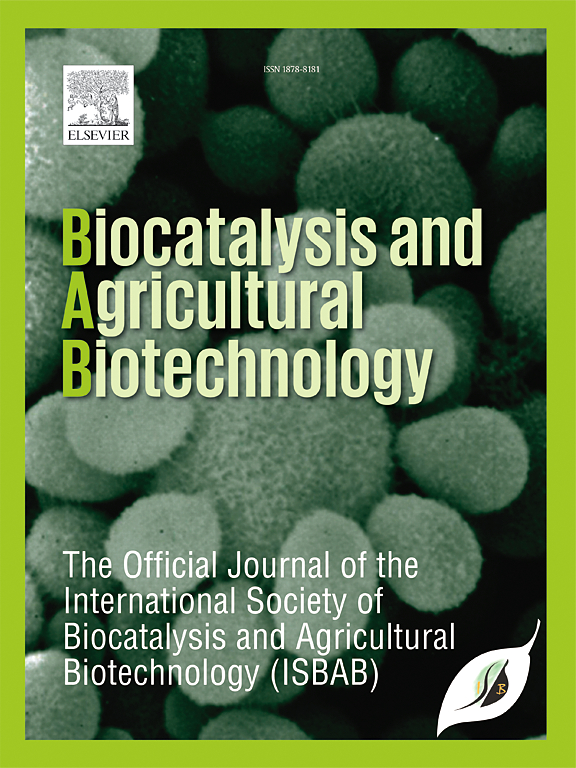Optimization of culture medium for Lacticaseibacillus paracasei DTA-83 to produce biopreservatives enhancing meat product durability
IF 3.8
Q2 BIOTECHNOLOGY & APPLIED MICROBIOLOGY
引用次数: 0
Abstract
The study aimed to produce a biopreservative using Lacticaseibacillus paracasei DTA-83 in an axenic culture system with an optimized medium derived from de Man, Rogosa, and Sharpe (MRS) broth. The effects of peptone, yeast extract, glucose, tribasic ammonium citrate, sodium acetate, magnesium sulfate, and dipotassium phosphate on biomass production and medium acidification by L. paracasei DTA-83 were evaluated using a fractional factorial design, followed by a central composite rotatable design. The biopreservative's ability to improve the durability of vacuum-packed cooked sausages, bacon, and sliced cooked ham, produced on an industrial pilot scale, was assessed using the microbial growth predictor MicroLab_ShelfLife. Biopreservatives produced with original MRS broth and untreated samples served as controls. Results showed glucose, yeast extract, and dipotassium phosphate were crucial for both biomass production and acidification. Peptone and sodium acetate significantly influenced biomass production, while tribasic ammonium citrate mainly affected acidification. Magnesium sulfate had no significant impact on either. The optimized biopreservative significantly enhanced meat durability compared to non-optimized and control groups, with a synergistic effect observed when combined with cold storage. These findings suggest that L. paracasei DTA-83 has distinct nutritional needs for biomass production versus acidification, requiring different media compositions for inoculum preparation and biopreservative production. This approach could also be extended to complex media, such as fermented plant extracts or byproducts, in future research.
副干酪乳杆菌DTA-83制备生物防腐剂的培养基优化
本研究的目的是利用副干酪乳杆菌DTA-83在无菌培养体系中生产一种生物防腐剂,该培养体系采用从de Man, Rogosa, and Sharpe (MRS)肉汤中提取的优化培养基。采用分数因子设计评估蛋白胨、酵母提取物、葡萄糖、柠檬酸三碱铵、乙酸钠、硫酸镁和磷酸二钾对副干酪乳杆菌DTA-83的生物质产量和培养基酸化的影响,然后采用中心复合可旋转设计。使用微生物生长预测器MicroLab_ShelfLife评估了该生物防腐剂在工业中试规模生产的真空包装熟香肠、培根和熟火腿切片的耐久性。用原始MRS肉汤和未经处理的样品制备的生物防腐剂作为对照。结果表明,葡萄糖、酵母提取物和磷酸二钾对生物质生产和酸化都至关重要。蛋白胨和乙酸钠对生物质产量影响显著,而柠檬酸三铵主要影响酸化。硫酸镁对两者均无显著影响。与未优化组和对照组相比,优化后的生物保鲜剂显著提高了肉类的耐久度,并与冷藏结合使用时观察到协同效应。这些发现表明,副干酪乳杆菌DTA-83对生物质生产和酸化有不同的营养需求,需要不同的培养基组成来制备接种物和生产生物防腐剂。在未来的研究中,这种方法也可以扩展到复杂的培养基,如发酵的植物提取物或副产品。
本文章由计算机程序翻译,如有差异,请以英文原文为准。
求助全文
约1分钟内获得全文
求助全文
来源期刊

Biocatalysis and agricultural biotechnology
Agricultural and Biological Sciences-Agronomy and Crop Science
CiteScore
7.70
自引率
2.50%
发文量
308
审稿时长
48 days
期刊介绍:
Biocatalysis and Agricultural Biotechnology is the official journal of the International Society of Biocatalysis and Agricultural Biotechnology (ISBAB). The journal publishes high quality articles especially in the science and technology of biocatalysis, bioprocesses, agricultural biotechnology, biomedical biotechnology, and, if appropriate, from other related areas of biotechnology. The journal will publish peer-reviewed basic and applied research papers, authoritative reviews, and feature articles. The scope of the journal encompasses the research, industrial, and commercial aspects of biotechnology, including the areas of: biocatalysis; bioprocesses; food and agriculture; genetic engineering; molecular biology; healthcare and pharmaceuticals; biofuels; genomics; nanotechnology; environment and biodiversity; and bioremediation.
 求助内容:
求助内容: 应助结果提醒方式:
应助结果提醒方式:


